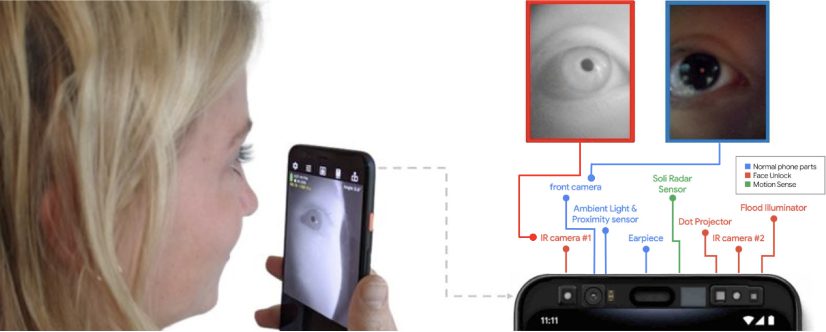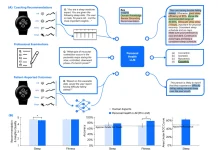The RGB selfie camera and the front-facing near-infrared camera equipped for facial recognition can be used to capture an image of the eye. The results of this imaging could be utilized to determine the user's cognitive condition.
Scientists at the University of California, San Diego, have created a smartphone app to help patients screen for Alzheimer’s disease, ADHD, and other neurological diseases and disorders by taking close-ups of their eyes.
Image Source: At-Home Pupillometry using Smartphone Facial Identification Cameras.
The program tracks how a person’s pupil changes in size using a near-infrared camera, which is included in modern smartphones for facial identification, as well as a standard selfie camera. These pupil measurements could be used to evaluate a person’s mental health.
The technique utilizes a NIR front-facing camera for facial identification, combined with the RGB selfie camera to detect absolute pupil dilation with sub-millimeter accuracy.
While there is still a lot of work to be done, I am excited about the potential for using this technology to bring neurological screening out of clinical lab settings and into homes. We hope that this opens the door to novel explorations of using smartphones to detect and monitor potential health problems earlier on.
Colin Barry, an electrical and computer engineering Ph.D. student at UC San Diego and the first author of the paper, which received an Honorable Mention for Best Paper award.
Pupillometry
Pupillometry is the investigation of minute changes in pupil diameter as a result of a stimulus. Pupillometry is made possible by pupillometers, which are specialized equipment that measure the pupil. The pupil is the portion of the eye that permits light to pass through the colored iris and into the retina, where light-sensitive cells react to the incoming light to give us our vision.
Like the aperture of a camera, the pupil can dilate or shrink to change the amount of light that enters the eye or the depth of the field of view. On the other hand, the pupil does not just react to light.
The pupil is linked to a number of complicated brain processes, resulting in a relationship between pupillary response and cognition, arousal, and emotion. The link between pupillary response and neurological processes has led to clinical studies into how pupillary response is linked to neurological illnesses such as Alzheimer’s, schizophrenia, and Parkinson’s disease.
According to current studies, pupil size can reveal information about a person’s neurological functions when a person performs a tough cognitive task or hears an unexpected sound, for example, pupil size increases.
Pupillometry Applications
A pupil response test is used to determine how much the pupil diameter changes over time. The test could provide a quick and painless technique to detect and track a variety of neurological diseases and disorders. However, performing tests outside of a lab or clinic is currently impractical because it involves specialized and expensive equipment.
Smartphone Pupillometry
Digital Health Lab Engineers, led by UC San Diego electrical and computer engineering professor Edward Wang, worked with scientists at the UC San Diego Center for Mental Health Technology (MHTech Center) to build a more inexpensive and accessible solution.
A scalable smartphone assessment tool that can be used for large-scale community screenings could facilitate the development of pupil response tests as minimally-invasive and inexpensive tests to aid in the detection and understanding of diseases like Alzheimer’s disease. This could have a huge public health impact.
Eric Granholm, a psychiatry professor at UC San Diego School of Medicine and director of the MHTech Center
Image Source: At-Home Pupillometry using Smartphone Facial Identification Cameras.
The UC San Diego team’s program detects a person’s pupil using a smartphone’s near-infrared camera. Even in eyes with darker iris hues, the pupil can easily distinguish from the iris in the near-infrared range. This allows the app to determine pupil size with sub-millimeter precision across a wide range of eye colors. The app also captures the stereoscopic distance between the smartphone and the user using a color selfie captured with the smartphone’s selfie camera. The software then converts the pupil size from the near-infrared image to millimeter units using this distance.
The measurements taken by the app were equivalent to those taken by a pupillometer, the gold standard for determining pupil size.
The researchers also added a number of features to their app to make it more user-friendly for the elderly.
For us, one of the most important factors in technology development is to ensure that these solutions are ultimately usable for anyone. This includes individuals like older adults who might not be accustomed to using smartphones.
Colin Barry
Researchers collaborated with older adults to create a simple app interface that allows users to administer pupil response tests themselves. The interface included voice instructions, image-based directions, and a cheap, plastic scope that directed the user to place their eye within the view of the smartphone camera.
By testing directly with older adults, we learned about ways to improve our system’s overall usability and even helped us innovate older adult specific solutions that make it easier for those with different physical limits to still use our system successfully. When developing technologies, we must look beyond function as the only metric of success, but understand how our solutions will be utilized by end-users who are very diverse.
Wang, faculty member in the UC San Diego Design Lab
Future Prospects
The Digital Health Lab is working on a project to make similar pupillometry functions available on every smartphone, not only newer ones. Future research will include working with older folks to assess how they use technology at home. The researchers will use older people with modest cognitive impairment to test the app as a risk screening tool for Alzheimer’s disease in its early stages.
Story Source: Colin Barry, Jessica de Souza, Yinan Xuan, Jason Holden, Eric Granholm, and Edward Jay Wang. 2022. At-Home Pupillometry using Smartphone Facial Identification Cameras. In CHI Conference on Human Factors in Computing Systems (CHI ’22), April 29-May 5, 2022, New Orleans, LA, USA. ACM, New York, NY, USA 12 Pages. https://doi.org/10.1145/3491102.3502493 https://www.universityofcalifornia.edu/news/diagnosing-neurological-disease-home
Dr. Tamanna Anwar is a Scientist and Co-founder of the Centre of Bioinformatics Research and Technology (CBIRT). She is a passionate bioinformatics scientist and a visionary entrepreneur. Dr. Tamanna has worked as a Young Scientist at Jawaharlal Nehru University, New Delhi. She has also worked as a Postdoctoral Fellow at the University of Saskatchewan, Canada. She has several scientific research publications in high-impact research journals. Her latest endeavor is the development of a platform that acts as a one-stop solution for all bioinformatics related information as well as developing a bioinformatics news portal to report cutting-edge bioinformatics breakthroughs.










